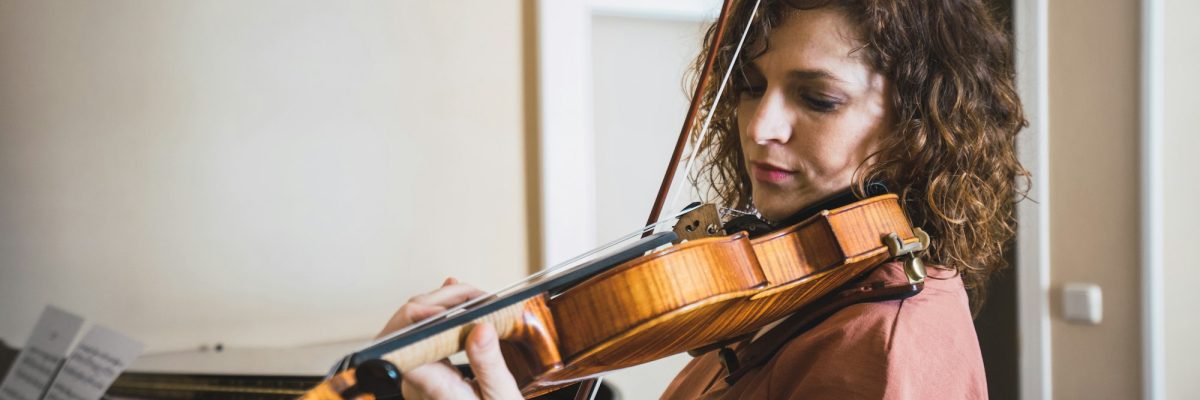The violin, a delicate and complex instrument, requires consistent care and maintenance to preserve its quality and sound. Whether you are a beginner or an experienced violinist, understanding the dos and don’ts of violin care is crucial. This blog post will guide you through the essential practices for maintaining your violin, ensuring it plays beautifully for years to come.
The Dos of Violin Care
-
Regular Cleaning
Do: Clean your violin regularly. Use a soft, dry cloth to wipe away rosin dust from the strings and body after every use. This prevents the buildup of grime and maintains the violin’s appearance and sound.
-
Proper Storage
Do: Store your violin in a case when not in use. This protects it from dust, humidity, and accidental damage. Ensure the case is sturdy and well-padded to provide adequate protection.
-
Humidity Control
Do: Monitor the humidity where your violin is stored. Wood expands and contracts with humidity changes, which can lead to cracks. Aim to maintain a consistent humidity level, ideally between 40-60%.
-
Regular Tuning
Do: Tune your violin regularly using a reliable tuner. This not only ensures your instrument sounds its best but also maintains tension across the bridge. This is vital for structural integrity.
-
Professional Maintenance
Do: Schedule regular check-ups with a professional luthier. They can spot and address issues like open seams or a misaligned sound post that might be difficult for an untrained eye to notice.
The Don’ts of Violin Care
-
Avoid Extreme Temperatures
Don’t: Expose your violin to extreme temperatures. Avoid leaving it in places like a car on a hot day or near heaters, as extreme heat can cause the wood to warp or the varnish to melt.
-
Neglecting String Replacement
Don’t: Neglect to replace old or frayed strings. Old strings not only sound poor but can also snap unexpectedly, potentially causing damage.
-
Handling the Bow Incorrectly
Don’t: Touch the bow hair with your fingers. The oil from your skin can damage the hair and affect its ability to grip the strings. Also, remember to loosen the bow hair after playing to maintain its tension.
-
Self-Repair Attempts
Don’t: Attempt complex repairs yourself. Activities like adjusting the sound post or gluing open seams should be left to professionals. DIY repairs can lead to further damage.
-
Using Inappropriate Cleaners
Don’t: Use household cleaners or alcohol on your violin. These can damage the varnish and wood. Stick to products specifically designed for violins.
Additional Tips for Violin Care
-
Bow Care
Your bow is an extension of your violin and needs equal attention. Rehair your violin regularly, and check for warping. Always use high-quality rosin to maintain the right amount of friction on the strings.
-
String Maintenance
Wipe your strings with a clean cloth after playing to remove rosin and oil. This prolongs their life and maintains sound quality. Also, consider the type of strings that best suit your violin and playing style. Different materials can drastically change the instrument’s sound.
-
Fingerboard and Bridge Care
The fingerboard and bridge are crucial for sound production. Keep the fingerboard clean and free of rosin buildup. The bridge should be regularly checked for proper alignment. If it starts to warp or lean, have it adjusted by a professional.
-
Regular Play
Playing your violin regularly is not just good for practice, but it’s also beneficial for the instrument. Regular play keeps the components working and can help you notice any changes in sound or playability that might indicate maintenance needs.
-
Educate Yourself
Learn about your instrument. Understanding its parts and how they work together can help you better maintain it. Knowledge of violin anatomy will also make communicating with a luthier more effective.
Next Steps
Caring for your violin is a blend of meticulous maintenance, regular check-ups, and mindful handling. By following these dos and don’ts, you can ensure that your violin remains in top condition, producing the best sound for your performances.
Remember, every violin is unique and may have specific needs. It’s always beneficial to seek advice from experienced violinists or luthiers who understand the nuances of your particular instrument.
In 2024, the importance of caring for traditional musical instruments remains as relevant as ever. In a world where digital music and synthetic instruments are on the rise, the charm and soul of a well-maintained violin stand out. Your dedication to your instrument’s care is not just a commitment to its longevity but also to the preservation of a rich musical tradition.
Cherish your violin, give it the care it deserves, and let it sing its history and your passion with every note you play.

A native of Florida, Cindy grew up with a rich family history of music. Starting with piano at age 9, she added flute and other instruments to her repertoire in junior high. She made all-county band and played piano for her school’s jazz band and show choirs. Throughout her teen years, she also had opportunities to perform in her local community in churches, assisted living facilities, plays, and productions. While pursuing her college degree in education, she traveled as the pianist for a college-sponsored singing group in 48 states over five summers. She has now been teaching music, including instruments and voice, since 1995. She has instructed students of all ages and skill levels, and many of her students from decades past now are teaching their own music students.


